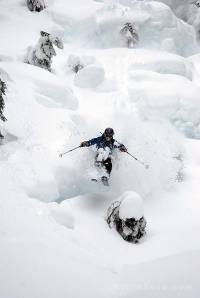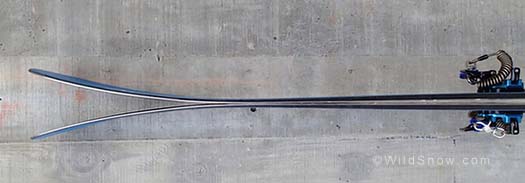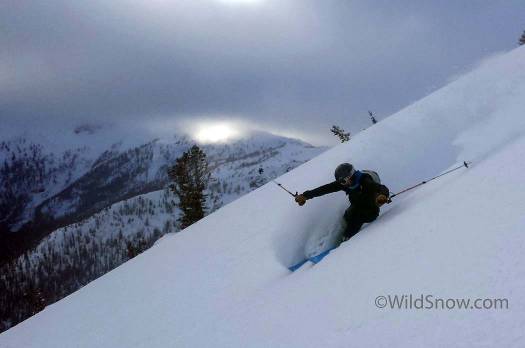Jason Davis

DPS Lotus 120’s camber and stiffness make it easy to stay upright during pillow extermination missions. Click to enlarge.
“Pacific Northwest powder.” Perhaps that’s an oxymoron to those who ski in drier climates, but every winter the PNW-P draws me back to the mountains, and I freely admit that I’m completely addicted. While we might not get the dry, light, fluffy stuff of higher and colder ranges, we get record-breaking quantities of snow on a pretty consistent basis.
Unfortunately, Pacific Northwest pow doesn’t materialize as cowboy cold smoke except for a handful of times a season, which leaves us with a strange paradigm. Float on top and you’ll call it Baker-pow, sink and you shall know it as Cascade concrete. Thus, spend any length of time around the west side of the North Cascades in mid winter and you’ll find that we like our skis wide.
In deep snow, fat skis make everything easier and more fun, they take less work to turn, planing up on top of the snow at slower speeds and make breaking trail less of a chore — you get more cushion for the snow pushing.
Skis with modern shapes that combine sidecut and camber underfoot, with rockered and tapered tips and tails, can even carve 2-dimensional snow surprisingly well.
Big skis have one huge drawback for the uphill skier though: they’re heavy. I’m lucky enough to have a lighter, skinnier pair for 2-D snow and bigger objectives so I’m not looking for the one-ski quiver. I’m after surfy, chargy pow boards that make no compromises on the down and are still light enough to be part of a dedicated touring rig for winters in the PNW.
Enter the DPS Lotus 120. In DPS’s new Pure3 construction at 189cm long and with dimensions of 140/122/126, this is a big ski, but the big ski heft is conspicuously absent. I measured them to be just a hair under 2kg per ski in the tested length, lighter than the 2012-2013 178cm Hybrid Lotus 120’s they replaced. In fact, these have a different shape and ski quite differently from the hybrids I was used to.

The tip has a flatter profile combined with the ski’s more centered mount point that seems to increase the usable surface area of the ski and decrease the amount that the tips bounce around in cut up or variable snow.
The shorter 35m sidecut radius doesn’t seem to detract from the ski’s high speed stability and you can actually get them to carve on groomed snow if you’re going fast enough, which is a definite change from the hybrids. That being said, if you’re looking for a bouncy powder ski to milk figure 8 turns, you’re in the wrong category.
DPS Lotus skis are certainly on the stiff side of the spectrum. Comparing them to other skis I’ve ridden in the same wide charger category, they’re stiffer overall than the 178 Hybrids, and 188cm Salomon Rocker2 115’s, but not quite as rigid as Blizzard’s 186cm 2012-2013 Bodacious.
Flex of the Lotus is nicely uniform throughout the cambered portion of the ski, softening up a bit in the rockered portion. This flex pattern has been perfect for the way I like to ski, with wide, fast arcs, occasional airs and the odd straightline thrown in. The softer tip keeps the ski from spearing into bumps, (a problem I had with the Bodacious) and lets the rocker keep the ski on the surface. The carbon in the ski gives them a liveliness that makes these more than just point and chute rocket ships. Going back to the Salomon Rocker2’s for a day left me wishing for the energy of the carbonated lotus. The Rocker2’s felt easy and forgiving where the Lotus was dynamic and powerful.
DPS aimed to dampen the twangy feel of their previous Pure construction by adding weight to the ski’s tips and tails (think adding a weight to a guitar string to change it’s resonance). It seems to work well. Overall the ski is plenty damp enough to back up its stiffness and this helps it stay stable when going scary fast. Interestingly Kastle tried to achieve the same goal by removing weights from the tips and tails of their skis, which sounds like a better option for a touring ski, but perhaps that wouldn’t work with the spooned tip. This is only something I noticed in harder snow, but the carbon feedback is still perceptible when skidding down harder snow, but it was never too unpleasant, and any ski this light, wide, and torsionally rigid is going to be jarring in those conditions, especially with tech bindings and stiff boots.
I was very interested to try out DPS’s spoon technology, which gives just the rockered tip a crease that basically creates a bevelled edge about one centimeter wide. In effect, while I found that the skis were certainly never hooky, I also couldn’t say that the spoon technology truly sets these skis apart. Basically it’s hard for me to tell that it has much of an effect and this is not surprising, as the bevel is very subtle and is also only present on the part of the ski that is exerting the least amount of pressure on the snow. I think I’d have to try a version without the spoon tech and one with it, back to back, to come to a definite conclusion.
I’ve been riding these with Plum Yaks and Dynafit Vulcans, and I’ve found that I’ve been having so much fun on these I’ve been completely ignoring my heavier downhill setup, even when I’m riding lifts. I even sold my Bodaciouses because they were just collecting dust. I’ve also noticed a big difference with this setup even when riding lifts in that I’m simply able to ski harder all day long because it is so light. I could usually ride inbounds hard for about half the day on my heavy setup before I’d need to dial it back, but with these I’ve been able to charge all day long without running out of energy.
The lack of weight also makes it easy to throw these sideways when going slower in steep, tight trees or other technical terrain, and they are perfectly capable of jump turns in narrow couloirs. The camber underfoot also helps in these situations and gives them a predictable grip on the skintrack. The tail isn’t completely flat, but it’s close and doesn’t get in the way on kickturns like fully rockered skis can.
In any case, these skis have simply been the most fun pow-slaying boards I’ve ever ridden and I’ll be holding on to these for as long as I can. For those who are accessing big lines under their own power, and like a powerful ski with a flat tail, these should be on your radar.
(Guest blogger Jason Davis is a climber, kayaker and skier living in the Pacific North Wet. He works as a sea kayak guide for Discovery Sea Kayaks on San Juan Island, WA during the warmer months and searches for good views, aesthetic lines and soft snow while attempting to work as little as possible during the winter. His other hobbies include spaghetti western card games and enjoying vigorous legal debates with polite Canadian Border Guards.)
Beyond our regular guest bloggers who have their own profiles, some of our one-timers end up being categorized under this generic profile. Once they do a few posts, we build a category. In any case, we sure appreciate ALL the WildSnow guest bloggers!



